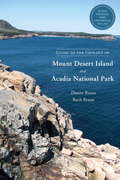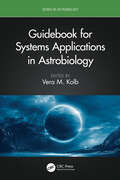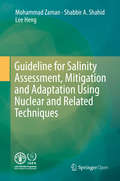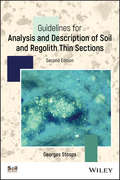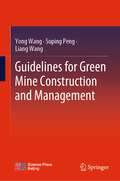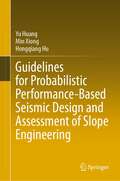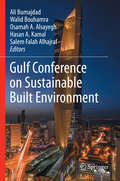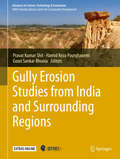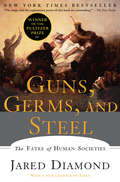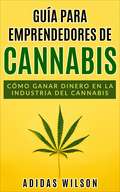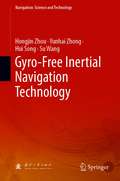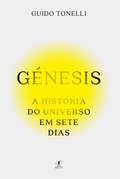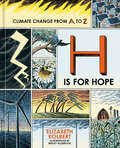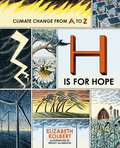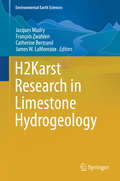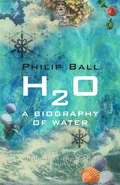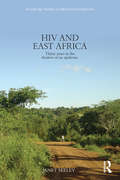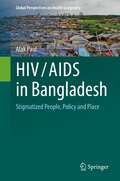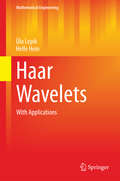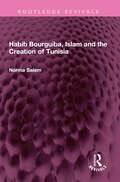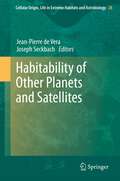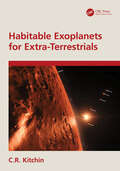- Table View
- List View
Guide to the Geology of Mount Desert Island and Acadia National Park
by Sarah Hall Duane Braun Ruth BraunThis richly-illustrated, full-color guide to the geology of Mount Desert Island, Maine, the home of Acadia National Park, makes the spectacular scenery and rich geological history accessible to outdoor explorers, geology enthusiasts, and armchair travelers alike. The Guide grounds readers in basic geologic concepts before chronicling the unique history of the area from 550 million years ago to the present. Including information-packed self-guided trips with stops at 31 points of interest, this book is lavishly illustrated with 100 full color photos, maps, and illustrations that enhance appreciation of this national treasure.Duane and Ruth Braun relate the fascinating story of the region's formation, explaining how a slice of South America with Mount Desert Island bordering its southern side landed on the edge of North America to form Maine. Another piece of South America collided with this landing, causing Mount Desert Island to erupt violently in a ten mile wide volcanic caldera. The Island then underwent a long period of stream erosion culminating in a period of glacial erosion to form the present landscape. The exceptional scenery that resulted has attracted visitors from around the world. This book unlocks the many secrets of the formations, offering a deeper understanding of the land and its origins.
Guidebook for Systems Applications in Astrobiology (Series in Astrobiology)
by Vera M. KolbThis book addresses the timely subject of systems applications in astrobiology. It demonstrates how astrobiology – a multidisciplinary, interdisciplinary, and transdisciplinary field of science – can benefit from adopting the systems approach. Astrobiology draws upon its founding sciences, such as astronomy, physics, chemistry, biochemistry, geology, and planetary sciences. However, astrobiologists can encounter difficulties working across these fields. The systems approach, we believe, is the best contemporary approach to consider astrobiology holistically. The approach is currently used in other fields, such as engineering, which uses systems analysis routinely. Such an approach needs to be learned, both in principle and through examples, from the field. This book features chapters from experts across the field of astrobiology who have applied the systems approach. It will be a valuable guide for astrobiology students at the advanced undergraduate and graduate levels, in addition to researchers in the field, both in academia and the space industry. Key Features: Offers a unique and novel approach to studying and understanding astrobiology Encourages astrobiologists to apply a holistic systems approach to their work, rather than being bogged down in details Imparts practical knowledge to readers which can be adopted in different research and job opportunities in the field of astrobiology Vera M. Kolb obtained degrees in chemical engineering and organic chemistry from Belgrade University, Serbia, and earned her PhD in organic chemistry from Southern Illinois University, Carbondale, Illinois, United States. Following a 30-year career, she is Professor Emerita of Chemistry at the University of Wisconsin-Parkside, Kenosha, Wisconsin. During her first sabbatical leave with the NASA Specialized Center of Research and Training (NSCORT) in Astrobiology, she conducted research with Dr. Leslie Orgel at the Salk Institute and Prof. Stanley Miller at UC San Diego. Her second sabbatical was with Prof. Joseph Lambert at Northwestern University, where she studied sugar silicates and their potential astrobiological relevance. She is credited for authoring over 160 publications, in the fields of organic and medicinal chemistry, green chemistry, and astrobiology, including several books. Recently, she authored Green Organic Chemistry and Its Interdisciplinary Applications (CRC 2016). In the astrobiology field, she edited Astrobiology: An Evolutionary Approach (CRC 2015) and Handbook of Astrobiology (CRC 2019). She co-authored (with Benton C. Clark) Astrobiology for a General Reader: A Questions and Answers Approach (CSP 2020) and Systems Approach to Astrobiology (CRC 2023).
Guideline for Salinity Assessment, Mitigation and Adaptation Using Nuclear and Related Techniques
by Shabbir A. Shahid Lee Heng Mohammad ZamanThis open access book is an outcome of the collaboration between the Soil and Water Management & Crop Nutrition Section, Joint FAO/IAEA Division of Nuclear Techniques in Food and Agriculture, Department of Nuclear Sciences and Applications, International Atomic Energy Agency (IAEA), Vienna, Austria, and Dr. Shabbir A Shahid, Senior Salinity Management Expert, Freelancer based in United Arab Emirates.The objective of this book is to develop protocols for salinity and sodicity assessment and develop mitigation and adaptation measures to use saline and sodic soils sustainably. The focus is on important issues related to salinity and sodicity and to describe these in an easy and user friendly way. The information has been compiled from the latest published literature and from the authors’ publications specific to the subject matter. The book consists of six chapters. Chapter 1 introduces the terms salinity and sodicity and describes various salinity classification systems commonly used around the world. Chapter 2 reviews global distribution of salinization and socioeconomic aspects related to salinity and crop production. Chapters 3 covers comprehensively salinity and sodicity adaptation and mitigation options including physical, chemical, hydrological and biological methods. Chapter 4 discusses the efforts that have been made to demonstrate the development of soil salinity zones under different irrigation systems. Chapter 5 discusses the quality of irrigation water, boron toxicity and relative tolerance to boron, the effects of chlorides on crops. Chapter 6 introduces the role of nuclear techniques in saline agriculture.
Guidelines for Analysis and Description of Soil and Regolith Thin Sections (ASA, CSSA, and SSSA Books #184)
by Georges StoopsA revised guide to the study and of soil and regolith thin sections A specialized system of terms and concepts must be used to accurately and effectively distinguish and name the microscopic features of soils and regoliths. With a comprehensive, consistent terminology at their disposal, researchers may compare, store and discuss new data easily and with less risk of error. The second edition of Guidelines for Analysis and Description of Soil and Regolith Thin Sections has been assembled to address this need, offering a practical system of analysis and description to those working with soil and regolith materials. This essential resource includes: An introduction to micromorphology and its practice Guidelines for the study of thin sections Sections covering the various microscopic features of soils and regoliths Illustrative graphics and colour micrographs Suggested description schemes and data presentation tips By providing an economical, navigable system for the study and documentation of soils and regoliths, Guidelines for Analysis and Description of Soil and Regolith Thin Sections, second edition, offers invaluable guidance for soil scientists, geologists, ecologists, archaeologists and all those concerned with micromorphology.
Guidelines for Green Mine Construction and Management
by Liang Wang Yong Wang Suping PengThis book comprehensively covers many aspects of green mine, including the basic situation of green mines, mine facilities, extraction management, ecological environment, scientific and technological innovation, standardized management, environmental protection inspectors, and special tools in response to the needs of green mine construction, assessment, and management. It is highly informative with valuable techniques and tools providing insights both for scholars and practitioners working in green mine field.
Guidelines for Probabilistic Performance-Based Seismic Design and Assessment of Slope Engineering
by Yu Huang Min Xiong Hongqiang HuThis book provides a new design and evaluation framework based on slope Stochastic Dynamics theory to probabilistic seismic performance for slope engineering. For the seismic dynamic stability safety of slope, it shifts from deterministic seismic dynamic analysis to quantitative analysis based on nonlinear stochastic dynamics, that is, from qualitative to the description of stochasticity of earthquake excitation that meet the needs in related design specification and establish a performance standard. In the nonlinear dynamic time history analysis of slope subjected to seismic ground motion, the term “randomness” is used to express the uncertainty in the intensity and frequency of earthquake excitation for slope engineering dynamic seismic performance. It mainly includes seismic design fortification standard, corresponding ground motion excitation, performance index threshold, and slope deterministic nonlinear seismic dynamic response. Even more than that, the seismic dynamic large deformation approaches of the whole process and comprehensive analysis for flow analysis after slope instability failure. Eventually, the probabilistic seismic dynamic performance of the slope engineering will be characterized by nonlinear dynamic reliability.
Gulf Conference on Sustainable Built Environment
by Ali Bumajdad Walid Bouhamra Osamah A. Alsayegh Hasan A. Kamal Salem Falah AlhajrafThis volume brings together outstanding contributions to the Gulf Conference on Sustainable Built Environment, held at the Marina Hotel Kuwait, near Kuwait City. The Proceedings collects 29 papers on a range of engineering and materials challenges, and best practices, addressing development of new sustainable building materials, performance improvement of structures and tall buildings, developing monitoring and analysis techniques and frameworks for existing infrastructure under environmental effects, development of long-term sustainability plans for building stock, and development of energy efficient buildings in the gulf region. The Conference was organized by the Kuwait Foundation for the Advancement of Sciences (KFAS), the Massachusetts Institute of Technology, the Kuwait Institute for Scientific Research, and Kuwait University.
Gully Erosion Studies from India and Surrounding Regions (Advances in Science, Technology & Innovation)
by Hamid Reza Pourghasemi Gouri Sankar Bhunia Pravat Kumar ShitThis book offers the scientific basis for the ample evaluation of badland management in India and some surrounding regions. It examines the processes operating in the headwaters and main channels of ephemeral rivers in lateritic environments of India. In particular, the book covers a range of vital topics in the areas of gully erosion and water to soil erosion at lateritic uplands regions of India and other regions in Asia. It explores the probable gully erosion modeling through Remote Sensing & GIS Techniques. It is divided into three units. Unit I deals with the introduction of badland, types of badland and the process of badland formation. Unit II is devoted to a description of quantitative measurements. Unit III deals with the control and management processes related to various issues from different regions. As such this book serves as a reference book for research activities in this area. It is an efficient guide for aspiring researchers in applied geography, explaining advanced techniques to help students recognize both simple and complex concepts.
Gunflint Falling: Blowdown in the Boundary Waters
by Cary J. GriffithStories from survivors of the Boundary Waters Canoe Area Wilderness&’s epochal weather disaster On July 4, 1999, in the Boundary Waters Canoe Area Wilderness (BWCAW), a bizarre confluence of meteorological events resulted in the most damaging blowdown in the region&’s history. Originating over the Dakotas, the midsummer windstorm developed amid unusually high heat and water-saturated forests and moved steadily east, bearing down on Fargo, North Dakota, and damaging land as it crossed the Minnesota border. Gunflint Falling tells the story of this devastating storm from the perspectives of those who were on the ground before, during, and after the catastrophic event—from first-time visitors to the north woods to returning paddlers to Forest Service Rangers. The pre-dawn forecasts from the National Weather Service in Duluth for that Sunday of the holiday weekend predicted the day would be &“warm and humid. Partly sunny with a thirty percent chance of thunderstorms.&” But as the afternoon and evening settled over the Boundary Waters, the first eyewitness accounts began to tell a dramatic and terrifying story. Five friends camping on Lake Polly watched in wonder as the sky turned green and the winds began to whip. They scrambled to pull canoes on shore and secure tarps when a tree snapped and struck one of them in the head, rendering her unconscious. Three women enjoying their last day of a camping trip near the end of the Gunflint Trail took shelter in their tent as winds increased. Water drenched the nylon walls as trees crashed around them, one flattening the tent and pinning a woman beneath its weight. A family vacationing at their cabin dodged falling trees and strained against straight-line winds as they sprinted from the cabin to the safest place they knew: a crawl space underneath it. They watched in awe as trees snapped and toppled, their twisted root balls torn out of the water-logged earth—as they prayed their cabin would hold. By the time the storm began to subside, falling trees had injured approximately sixty people, and most needed to be medevacked to safety. Amazingly, no one died. The historic storm laid down timber that would later blaze in the Ham Lake fire of 2007, ultimately reshaping the region&’s forests in ways we have yet to fully understand.
Guns, Germs, and Steel: The Fates of Human Societies
by Jared Diamond"Fascinating.... Lays a foundation for understanding human history."—Bill Gates In this "artful, informative, and delightful" (William H. McNeill, New York Review of Books) book, Jared Diamond convincingly argues that geographical and environmental factors shaped the modern world. Societies that had had a head start in food production advanced beyond the hunter-gatherer stage, and then developed religion --as well as nasty germs and potent weapons of war --and adventured on sea and land to conquer and decimate preliterate cultures. A major advance in our understanding of human societies, Guns, Germs, and Steel chronicles the way that the modern world came to be and stunningly dismantles racially based theories of human history. Winner of the Pulitzer Prize, the Phi Beta Kappa Award in Science, the Rhone-Poulenc Prize, and the Commonwealth club of California's Gold Medal.
Guía para emprendedores de cannabis: Cómo ganar dinero en la industria del cannabis
by Adidas WilsonLa industria legal del cannabis ha crecido un 75% en su primer año. Este es solo el comienzo. Continuará creciendo a medida que se hagan o revisen más leyes a su favor. Algunos expertos predicen que la industria podría valer miles de millones en los próximos cinco años. Entonces, ¿cómo puedes ganar dinero legalmente con la marihuana? Si cuentas con un conjunto de habilidades valiosas, será fácil encontrar trabajo en la industria. Este podría ser ventas, marketing, tecnología, contabilidad, diseño y, básicamente, cualquier otra cosa que pueda necesitar una empresa del sector de la marihuana. También existe una gran demanda de puestos auxiliares. El mercado de la marihuana se encuentra estrictamente regulado, y esto crea muchas oportunidades.
Gyro-Free Inertial Navigation Technology (Navigation: Science and Technology #7)
by Hui Song Hongjin Zhou Yunhai Zhong Su WangThis book focuses on gyro-free inertial navigation technology, which is used to measure not only linear motion parameters but also angular rates. Since no gyroscopes are used, the key technologies, such as initial alignment, attitude resolution, and error calibration, are very different than those used in traditional methods.Discussing each key technology in gyro-free inertial navigation system (GFINS) manufacture in a separate chapter, the book features easy-to-understand, detailed illustrations, to allow all those involved in inertial navigation to gain a better grasp of GFINS manufacture, including accelerometer setting principles; initial alignment; quaternion-based, attitude resolution algorithms; and accelerometer de-noise methods.
Génesis: The Story Of How Everything Began
by Guido TonelliTudo nasce de uma simples e inevitável pergunta: «De onde vem tudo isto?» Um ensaio admirável sobre o início de tudo que devolve à Humanidade a verdadeira história das suas origens. No princípio, era o caos. Talvez os gregos tivessem razão, já que muitas observações da física moderna parecem confirmá-lo. Mas o que aconteceu realmente nos primeiros instantes da vida do universo? Do caos descrito por Hesíodo ao bosão de Higgs, Guido Tonelli, renomado físico do CERN e professor na universidade de Pisa, emula a estrutura narrativa bíblica da criação do mundo em sete dias para relatar, em sete capítulos e assinalável fascínio, a estranha singularidade que permitiu a formação do universo e a sopa primordial de onde surgiu a Vida. Com inesperada simplicidade e incontestável poesia, Tonelli segue o fio condutor da consciência para responder à sempiterna pergunta: De onde vem tudo isto? A narração de como tudo começou, da formação das partículas, da matéria, das estrelas, dos humanos e do seu pensamento simbólico, de tudo quanto existe, portanto, é acompanhada pela recuperação dos mitos ancestrais criados e transmitidos de geração em geração em torno da origem do universo, bem como do relato de histórias fascinantes de cientistas que dedicaram a vida à investigação do enigma da origem, de Galileu a Stephen Hawking, com os seus momentos Eureka! e as histórias anedócticas que entraram para a história da ciência e do mundo. «Nós, os cientistas, somos como os homens na caverna de Platão: tentamos libertar-nos dos grilhões - conclusões erradas -, tentamos dar um nome às sombras, tentamos sair da caverna para ver a luz.» Guido Tonelli
H Is for Hope: Climate Change from A to Z
by Elizabeth KolbertIn twenty-six essays—one for each letter of the alphabet—the Pulitzer Prize-winning author of The Sixth Extinction takes us on a hauntingly illustrated journey through the history of climate change and the uncertainties of our future.Climate change resists narrative—and yet some account of what&’s happening is needed. Millions of lives are at stake, and upward of a million species. And there are decisions to be made, even though it&’s unclear who, exactly, will make them.In H Is for Hope, Elizabeth Kolbert investigates the landscape of climate change—from &“A&”, for Svante Arrhenius, who created the world&’s first climate model in 1894, to &“Z&”, for the Colorado River Basin, ground zero for climate change in the United States. Along the way she looks at Greta Thunburg&’s &“blah blah blah&” speech (&“B&”), learns to fly an all-electric plane (&“E&”), experiments with the effects of extreme temperatures on the human body (&“T&”), and struggles with the deep uncertainty of the future of climate change (&“U&”).Adapted from essays originally published in The New Yorker and beautifully illustrated by Wesley Allsbrook, H Is for Hope is simultaneously inspiring, alarming, and darkly humorous—a unique examination of our changing world.
H is for Hope: Climate Change from A to Z
by Elizabeth KolbertClimate change resists narrative – and yet we must see clearly what&’s happening in our world. Millions of lives are at stake, and upwards of a million species. We must act. 'To be a well-informed citizen of Planet Earth, you need to read Elizabeth Kolbert.' ROLLING STONE In H is for Hope, Elizabeth Kolbert investigates the history, and future, of climate change – from A, for Svante Arrhenius, who created the world&’s first climate model in 1894, to Z, for Net Zero. Along the way she looks at Greta Thunberg&’s &‘blah blah blah&’ speech, flies an all-electric plane, experiments with the effects of extreme temperatures on the human body, and struggles with the deep uncertainty of the future. Complemented by Wesley Allsbrook&’s gorgeous, colour illustrations, H Is for Hope offers an inspiring, worrying and, above all, hopeful vision for how we can still save our planet.
H2Karst Research in Limestone Hydrogeology
by James W. Lamoreaux Jacques Mudry François Zwahlen Catherine BertrandChapters in this book are contributions from the 9th Conference on limestone hydrogeology, organized in Besançon in September 2011 selected by the scientific committee of H2Karst. The book presents latest results on in the field of groundwater flow and storage within the different subsystems of karst aquifers; insights into the complex interaction between groundwater and surface water in karst areas by a multidisciplinary approach; current knowledge on contamination problems and contaminant transport in karst aquifers as well as an overview of karst hydrogeology in different contexts around the world.
H2O: A Biography Of Water
by Philip BallThe extent to which water remains a scientific mystery is extraordinary, despite its prevalence and central importance on Earth. Whether one considers its role in biology, its place in the physical world (where it refuses to obey the usual rules of liquids) or its deceptively simple structure, there is still no complete answer to the question: what is water? Philip Ball's book explains what, exactly, we do and do not know about the strange character of this most essential and ubiquitous of substances. H20 begins by transporting its readers back to the Big Bang and the formation of galaxies to witness the birth of water's constituent elements: hydrogen and oxygen. It then explains how the primeval oceans were formed four billion years ago; where water is to be found on other planets; why ice floats when most solids sink; why, despite being highly corrosive, water is good for us; why there are at least fifteen kinds of ice and perhaps two kinds of liquid water; how scientists have consistently misunderstood water for centuries; and why wars have been waged over it. Philip Ball's gloriously offbeat and intelligent book conducts us on a journey through the history of science, folklore, the wilder scientific fringes, cutting-edge physics, biology and ecology, to give a fascinating new perspective on life and the substance that sustains it. After reading this book, drinking a glass of water will never be the same again.
H2O: A Biography of Water
by Philip BallThe brilliantly told and gripping story of the most familiar - yet, amazingly, still poorly understood - substance in the universe: Water.The extent to which water remains a scientific mystery is extraordinary, despite its prevalence and central importance on Earth. Whether one considers its role in biology, its place in the physical world (where it refuses to obey the usual rules of liquids) or its deceptively simple structure, there is still no complete answer to the question: what is water? Philip Ball's book explains what, exactly, we do and do not know about the strange character of this most essential and ubiquitous of substances.H20 begins by transporting its readers back to the Big Bang and the formation of galaxies to witness the birth of water's constituent elements: hydrogen and oxygen. It then explains how the primeval oceans were formed four billion years ago; where water is to be found on other planets; why ice floats when most solids sink; why, despite being highly corrosive, water is good for us; why there are at least fifteen kinds of ice and perhaps two kinds of liquid water; how scientists have consistently misunderstood water for centuries; and why wars have been waged over it.Philip Ball's gloriously offbeat and intelligent book conducts us on a journey through the history of science, folklore, the wilder scientific fringes, cutting-edge physics, biology and ecology, to give a fascinating new perspective on life and the substance that sustains it. After reading this book, drinking a glass of water will never be the same again.
HIV and East Africa: Thirty Years in the Shadow of an Epidemic (Routledge Studies in African Development)
by Janet SeeleyBy tracing the shadow of the epidemic over the last 30 years in Uganda and more broadly in the region, HIV and East Africa investigates the impact of the epidemic on people’s lives and livelihoods, placing the epidemic within the context of the social, political and economic changes that have occurred over the last three decades. Whilst it inevitably touches on loss and suffering, the message is also about managing the impact of an epidemic which has had a profound impact on many lives. When one looks for traces in southern Uganda, once thought to be the epicentre of the epidemic, it is hard to see any lasting impact at a community wide level. Delve deeper and there are scars to be found among families and patterns of change which are a direct result of the epidemic The book goes on to explore the effect of improved treatment and care on perceptions of the epidemic and concludes by putting HIV into the context of other disease outbreaks, reflecting on what we can learn from the history of other epidemics as well as the last 30 years of the HIV epidemic.
HIV/AIDS in Bangladesh: Stigmatized People, Policy and Place (Global Perspectives on Health Geography)
by Alak PaulThis book aims to show the conditions and behaviors of vulnerable and marginalized people in Bangladesh which put them at risk of HIV/AIDS infection, and what their adopted coping strategies are and how these play out. In addition, the book seeks to gain an understanding of the perceptions of civil society and policy planners with respect to vulnerability to HIV, and the necessary mitigation measures. While there is much published literature on the epidemiology and etiology for the most at-risk groups in the region, there has not yet been any in-depth research concerning the socio-cultural and geographic impacts of HIV issues in Bangladesh. Almost all of the literature shows HIV as an epidemiological problem rather than investigating it from a social or cultural point of view, and still less using qualitative methods. The present work is an endeavor to fill these gaps by providing valuable qualitative field data to demonstrate the causes of HIV risk and vulnerability, and to examine the nature of the social and locational context of HIV/AIDS in Bangladesh and to assist with health care policy planning. The book will be of use to students and researchers, studying public health, health geography, medical sociology, medical anthropology, social psychology and social epidemiology, and to professionals in the fields of development, community medicine, health management and social policy.
HMH Science Dimensions™, Earth & Space Science (Hmh Science Dimensions Earth And Space Science Ser.)
by Michael R. Heithaus Michael J. PassowNIMAC-sourced textbook
Haar Wavelets
by Ülo Lepik Helle HeinThis is the first book to present a systematic review of applications of the Haar wavelet method for solving Calculus and Structural Mechanics problems. Haar wavelet-based solutions for a wide range of problems, such as various differential and integral equations, fractional equations, optimal control theory, buckling, bending and vibrations of elastic beams are considered. Numerical examples demonstrating the efficiency and accuracy of the Haar method are provided for all solutions.
Habib Bourguiba, Islam and the Creation of Tunisia (Routledge Revivals)
by Norma SalemFirst published in 1984, Habib Bourguiba, Islam and the Creation of Tunisia is a study of Habib Bourguiba, the founder of independent Tunisia, that argues that Islam played a vital role in the development of the Tunisian nationalist movement. This book is therefore both a biography of the Tunisian leader and a discussion of the role of Islam as the key to legitimacy throughout the Arab world. The author argues that Islam was such a fundamental component in defining the specificity of the Tunisian nation that even Bourguiba, the most secular of Arab leaders, could not shed the Arab-Islamic heritage of Tunisia. Instead, he used Islam as a principle mode of communication to mobilise the Tunisian masses. This book will be of interest to students of African studies, history, political science and religion.
Habitability of Other Planets and Satellites
by Joseph Seckbach Jean-Pierre de VeraIs the Earth the right model and the only universal key to understand habitability, the origin and maintenance of life? Are we able to detect life elsewhere in the universe by the existing techniques and by the upcoming space missions? This book tries to give answers by focusing on environmental properties, which are playing a major role in influencing planetary surfaces or the interior of planets and satellites. The book gives insights into the nature of planets or satellites and their potential to harbor life. Different scientific disciplines are searching for the clues to classify planetary bodies as a habitable object and what kind of instruments and what kind of space exploration missions are necessary to detect life. Results from model calculations, field studies and from laboratory studies in planetary simulation facilities will help to elucidate if some of the planets and satellites in our solar system as well as in extra-solar systems are potentially habitable for life.
Habitable Exoplanets for Extra-Terrestrials
by C.R. KitchinThis book explores the questions of What, Why, When, How and Where we might find Extra-Terrestrials (a.k.a. Aliens) and their habitats throughout the Universe – and Who might they be? Starting from ourselves and the Earth and eventually speculating about life-forms that might span multiple Universes, it provides an accessible introduction to extra-terrestrial life, the search for extra-terrestrial intelligence and exoplanets. It will enable readers to appreciate, follow and sometimes answer questions on life and planets outside Earth. It details these exciting topics by pondering what comprises an alien life form and what suitable habitats might exist for them inside and out of our solar system. The book also looks ahead to the future and the realities of finding alien life and the possibilities of mankind leaving Earth and living on another planet.This guide is accessible to those without a formal scientific or mathematical background. It will also be of interest to students of astrobiology, astronomy, astrophysics, planets throughout the Universe, the origin and evolution of life-forms beyond the Earth and (perhaps) of the ultimate limits attainable by life in the Universe, who are looking to learn more about those same topics, but which are outside their own specialisms.Key Features: Combines the exciting topics of extra-terrestrial life, the search for life outside Earth and exoplanets into one accessible guide Contains no complex mathematical formulae or content Authored by a professional educator and a professional and amateur astronomer, with a life-long interest in getting everyone and anyone as fascinated by astronomy and its related subjects as he himself has been, since discovering the subject in early secondary school
